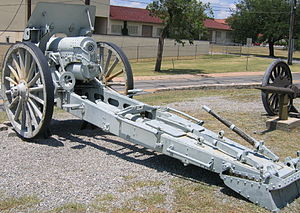M1908 6-inch howitzer: Difference between revisions
m →top: Linked articles, replaced: cased charge → cased charge using AWB |
in the US instead of stateside |
||
| Line 55: | Line 55: | ||
}} |
}} |
||
The '''6 inch Howitzer, Model of 1908''' was the standard American heavy [[howitzer]] before World War I. Forty-two of these weapons had been produced before 1917 and all were employed for training |
The '''6 inch Howitzer, Model of 1908''' was the standard American heavy [[howitzer]] before World War I. Forty-two of these weapons had been produced before 1917 and all were employed within the US for training in that war. Although this weapon appears in World War I-era [[Table of organization and equipment|tables of organization and equipment]], for combat use in France the [[Canon de 155 C mle 1917 Schneider]] was purchased, and remained the standard weapon of this class until early World War II.<ref>Rinaldi, p. 204</ref> All surviving weapons were retired during the 1920s.<ref name=Willi1>Williford, pp. 76-77</ref> |
||
It is unusual among American-designed field artillery weapons in that it has the recoil cylinder situated above the barrel. The 4.7-inch howitzer M1908/M1912 shared this feature.<ref>[http://warmemorials.us/artillery/m1912_4.7in_algoma.html Photos of 4.7-inch howitzer M1912 preserved in Algoma, Wisconsin]</ref><ref>Schreier Jr., Konrad F., "U.S. Army Field Artillery Weapons 1866-1917", ''Military Collector & Historian'', 1968, pp. 40-45</ref> The [[75 mm Gun M1917]] also had this, but was based on the British [[Ordnance QF 18-pounder]]. |
It is unusual among American-designed field artillery weapons in that it has the recoil cylinder situated above the barrel. The 4.7-inch howitzer M1908/M1912 shared this feature.<ref>[http://warmemorials.us/artillery/m1912_4.7in_algoma.html Photos of 4.7-inch howitzer M1912 preserved in Algoma, Wisconsin]</ref><ref>Schreier Jr., Konrad F., "U.S. Army Field Artillery Weapons 1866-1917", ''Military Collector & Historian'', 1968, pp. 40-45</ref> The [[75 mm Gun M1917]] also had this, but was based on the British [[Ordnance QF 18-pounder]]. |
||
Ammunition was either common steel shell with a base [[fuze]] or shrapnel with a combination time/percussion fuze.<ref>Handbook 1917, pp. 22-23</ref><ref name=Willi1/> |
Ammunition was either common steel shell with a base [[fuze]], or shrapnel with a combination time/percussion fuze.<ref>Handbook 1917, pp. 22-23</ref><ref name=Willi1/> |
||
==See also== |
==See also== |
||
Revision as of 20:51, 17 March 2019
| 6 inch Howitzer, Model of 1908 | |
|---|---|
 | |
| Type | Heavy howitzer |
| Place of origin | United States |
| Service history | |
| In service | 1910-1920 |
| Used by | United States |
| Wars | World War I |
| Production history | |
| Designer | Bethlehem Steel |
| Designed | 1906-1909 |
| Manufacturer | Gun: Watervliet Arsenal Carriage: Rock Island Arsenal, Bethlehem Steel |
| Produced | 1910-1916 |
| No. built | 42 |
| Specifications | |
| Mass | 7,354 lb (3,336 kg) |
| Barrel length | 81.5 in (207 cm) bore (13.6 calibers) |
| Crew | 9 |
| Shell | Separate loading cased charge |
| Shell weight | 120 lb (54 kg) common or shrapnel |
| Calibre | 6 in (152.4 mm) |
| Breech | Interrupted screw |
| Recoil | Hydrospring |
| Elevation | -5° to 40° |
| Traverse | 6° |
| Muzzle velocity | 900 ft/s (270 m/s) |
| Maximum firing range | 6,700 yards (6,125 m) (40° max elevation) |
The 6 inch Howitzer, Model of 1908 was the standard American heavy howitzer before World War I. Forty-two of these weapons had been produced before 1917 and all were employed within the US for training in that war. Although this weapon appears in World War I-era tables of organization and equipment, for combat use in France the Canon de 155 C mle 1917 Schneider was purchased, and remained the standard weapon of this class until early World War II.[1] All surviving weapons were retired during the 1920s.[2]
It is unusual among American-designed field artillery weapons in that it has the recoil cylinder situated above the barrel. The 4.7-inch howitzer M1908/M1912 shared this feature.[3][4] The 75 mm Gun M1917 also had this, but was based on the British Ordnance QF 18-pounder.
Ammunition was either common steel shell with a base fuze, or shrapnel with a combination time/percussion fuze.[5][2]
See also
Weapons of comparable role, performance and era
- 15 cm schwere Feldhaubitze M 94 : approximate Austro-Hungarian equivalent
- BL 6-inch 30 cwt howitzer : approximate British equivalent
- Rimailho Model 1904TR : approximate French equivalent
- 152 mm howitzer M1910 : approximate French/Russian equivalent
- 15 cm sFH 02 : approximate German equivalent
Gallery
-
In Ft. Bliss, TX in 1910s
-
In travelling position
References
- Ordnance Corps, United States Army (1917). Handbook of the 6-inch Howitzer Materiel, Model of 1908 and 1908MI. Washington: Government Printing Office.
- 108th Field Artillery (1918). Field Artilleryman's Guide, 3 inch Gun, 4.7 and 6 inch Howitzer, Second Edition. Philadelphia: P. Blakiston's Son & Co.
{{cite book}}: CS1 maint: numeric names: authors list (link) - Rinaldi, Richard A. (2004). The U. S. Army in World War I: Orders of Battle. General Data LLC. ISBN 0-9720296-4-8.
- Williford, Glen M. (2016). American Breechloading Mobile Artillery, 1875-1953. Atglen, Pennsylvania: Schiffer Publishing. ISBN 978-0-7643-5049-8.


